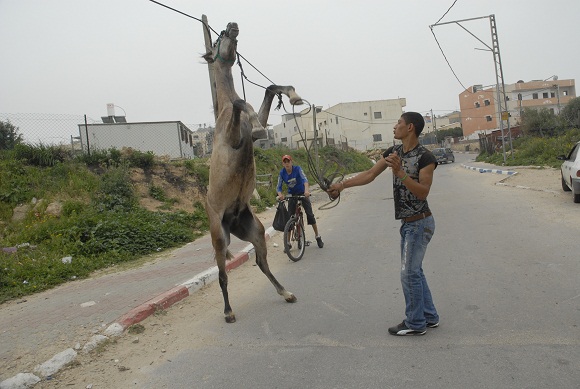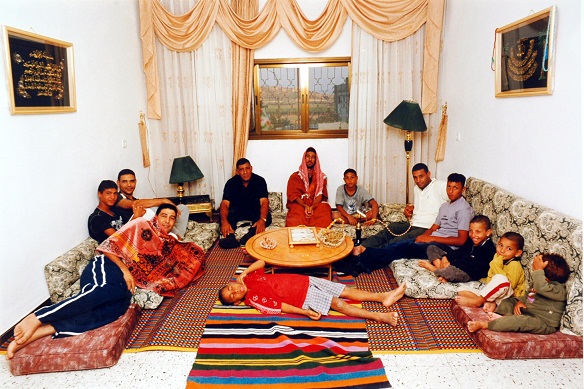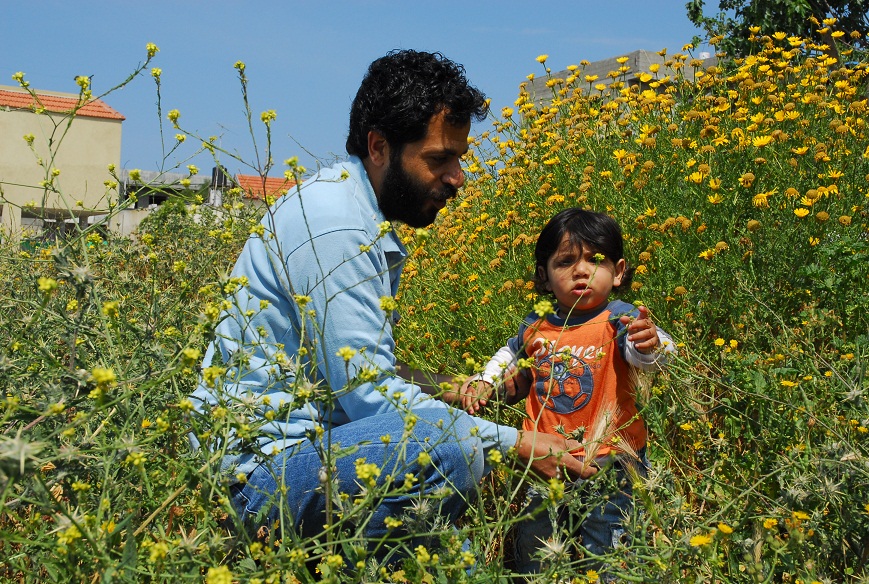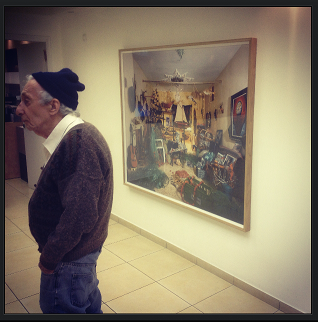The exhibit presents part of the photographs Ron Amir took in over than ten year of work in Jisr az-Zarqa, the only Palestinian village remained on the sea shore after the Nakba.
Opening: Wednesday, January 23, 2013, 7:30pm.
Zochrot's Visual Research Laboratory
34 Yitshak Sadeh st. 4th floor, room 400.
Open from Sunday to Thursday 10am - 3pm. Call to make sure: 03-6953155
Ron Amir talks to Eitan Bronstein Aparicio about his work and the exhibit:
Ron:
I first became acquainted with Jisr az-Zarqa in 1996, when I worked at Kibbutz Ma’agan Michael and went hiking in the area, along the coast. One day I wound up at Jisr’s fishing harbor – something about it fascinated me and made me very curious. Later I’d go to the village – for falafel, maybe. At some point after I began studying photography in 2000, I started taking pictures there. The subject of my first series of photos, in 2002, was, naturally, the beach – an ordinary beach for swimming, nothing unusual about it. I asked families to sit or stand however they wished for a family portrait. I didn’t know them yet, but I promised to give them copies of the photos – and I did.
When I went to the village to look for the families I’d photographed and give them copies of the pictures I found myself in the alleys in the heart of the village. When people asked me what I was looking for, I told them I wanted to find the people in the photographs so I could give them copies. That’s how I moved from photographing families on the beach to photographing them in their homes. For a year and a half I took pictures of four Jisr families, once or twice a week, and that became my finals project. Those photographs were much more private, even intimate, and were taken with a professional camera, with lighting, creating a sort of mini-studio in the homes.
Sometimes I initiated the photographs; sometimes they did. For example – Na’im and Ibtisar approached me asking to recreate for them photos prior to a wedding. They’d had a modest wedding and had no photos from it. Another reason they didn’t have photos of themselves as a couple is because religious Moslem couples don’t spend time together before the wedding and there are no pictures of the couple.
After I’d completed my finals project I kept returning to Jisr. I asked myself whether that was because it was easy for me, familiar, or whether I really was looking for something more. That’s when I realized that the project had just begun, because the connection to a particular place, the commitment to it, creates something in the photograph, in the gaze of the people being photographed. I felt that a project dealing with a specific population must proceed slowly, accrue over a long period of time. That led me to a deeper involvement with the locality, including four years of teaching photography to tenth-graders in the local school.
Eitan:
Zochrot was established during the time you began photographing in Jisr, and I remember meeting with Palestinians in Israel to talk about erecting signs to commemorate the demolished Palestinian villages. Their attitude was often very suspicious, the result, I assume, of the events of October, 2000, and Israel’s very violent response to its Arab citizens. Did you also experience a similar suspicious reaction? It can’t always be easy for a Jew to wander around an Arab village with a camera.
Ron:
Certainly. I don’t remember anything specifically connected to the events of October, 2000, but given the reality we live in, Arabs in Israel have many reasons to be suspicious. Photography is an aggressive, threatening medium and always arouses apprehensions. There’s a very delicate moment when the connection is made, in the interaction, and that’s one of the things I’m most interested in, because the photo arises out of the connection with the people, and sometimes the connection is more interesting that the resulting photographs. Residents became suspicious during my initial visits to the village – sometimes people approached me, other times they simply looked at me. Once I drove through an alley at night and someone bumped my car. I stopped to talk to him, asked whether he wanted something. He didn’t say much but he looked at me suspiciously. That made me show him the photos I’d taken during my last visit to the village. Then something switched. He asked me to come home with him and photograph. That tension, the delicate, fragile moment of the initial contact, interests me very much.
There’s always an ethical question involved in photographing the “other,” in the very act of taking the picture, in the balance of power between me and the people I’m photographing, and where the pictures end up…in a gallery, a museum, back to those photographed? These are complicated questions that I have to consider, to deal with. I feel that the way I work, engaging in long-term projects, taking my time, having a cumulative effect and a developing connection with the community, may be a way of answering these questions.
Eitan:
Did these interactions ever fail? You speak of the moment of tension, perhaps even temptation, certainly on your part, since your interest is obvious. Were you ever refused?
Ron:
Many times. For example, in one project I photographed from the roofs of houses in Jisr az-Zarqa. I tried to reverse the familiar perspective we get when we ride on the coastal road and look at the village from outside, and instead to photograph from inside, looking out. I contacted the owners of the houses from whose roofs I photographed, but I didn’t know the people I was photographing and they didn’t know they were being photographed. When I’d approach them and request permission to go up to the roof with my equipment, they sometimes said, “No, thank you.” Some also asked, “What are you going to do with all the pictures? And why from our roof?” I sometimes felt a note of accusation or defiance in the tone of their questions – “What do you want from us?”
Eitan:
How did you choose the photographs for this exhibit?
Ron:
This is an exhibit of photographs which were not originally intended to be displayed in a gallery or a museum, but addressed rather to the subjects of the photos themselves. They’re usually images taken in passing with a digital camera that happens to be in the car, and are usually done at the initiative of the subject who asks me to take his picture. For example, someone who asks me to come home and photograph him with his horse, or someone else wants me to photograph him with a damaged fishing net that got caught on the ground and torn during a police search, so the photo will be like one taken by an insurance adjustor in order to evaluate the damage. Or a group of youths who get together on weekends asks me to take their picture. These images result from my long-term presence in the community as part of my ongoing project, the acquaintance built up over time between me and the people being photographed. They already know me, are aware of my presence, and begin “using me.” I chose about 100 photos, printed them on paper 15x21 cm. (6 x 8 ¼ in.) and hung them on one wall. Some are portraits, some taken inside homes, some on the street and some at events like holiday celebrations or weddings. My interest was formal rather than narrative; I wanted to build a composition that helps viewers see the structure created on the wall while at the same time allows them to view the individual images as independent events.
A single image is displayed on the opposite wall which is in many ways the opposite or the antithesis of the wall it faces. It’s a photograph of Khaled Jarban in his house in 2008. It’s titled “On Kinneret’s shore,” 130x160 cm. (51 x 63 in.), in large format, with a technically sophisticated camera and a great deal of lighting. A very meticulous photograph that took many hours to create. It’s totally different from the ones on the opposite wall in the way it was made, its motivation and its purpose.
Eitan:
You’d known Khaled previously.
Ron:
I’d been told about Khaled’s house, and when I photographed him we’d already known each other for at least three years. The photo shows Khaled’s living room; he’s very interested in cultures, music, items he’s collected over the years. There are periods during which he sews his fishing nets at home, even though they’re not his main source of income. The photograph is, on the one hand, staged and meticulous, but possesses, on the other hand, documentary value – that’s actually how the room looks, and that’s how Khaled sits sewing his nets. The title, “On Kinneret’s Shore,” refers ironically to the sone of that name. The title refers to the fishing nets, and also, in the depths of the photograph, is Rubin’s painting, “On the road to Tiberias,” which extends the perspective of the space. Rubin’s painting was used on a poster for an exhibit at the Israel Museum in the 1990’s that was called “On Kinneret’s Shore.” I chose the single photograph placed opposite the multiple images to warn against turning the village into too obvious a symbol or metaphor. The photograph contains all of Jisr. The person photographed, his home, the fishing nets, references to Islam and other items. But, at the same time, there’s no way to know when or where it was taken.
9/1/2013

רון עמיר מצלם בג'סר א-זרקא / Ron Amir take photos at Jisr az-Zarqa

רון עמיר מצלם בג'סר א-זרקא / Ron Amir take photos at Jisr az-Zarqa

רון עמיר מצלם בג'סר א-זרקא / Ron Amir take photos at Jisr az-Zarqa

ערב הפתיחה על שפת ים / Opening event On Sea Shore


